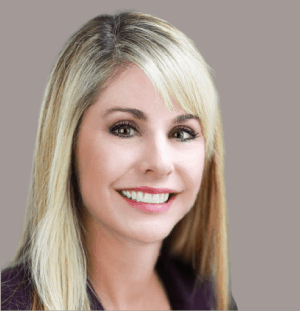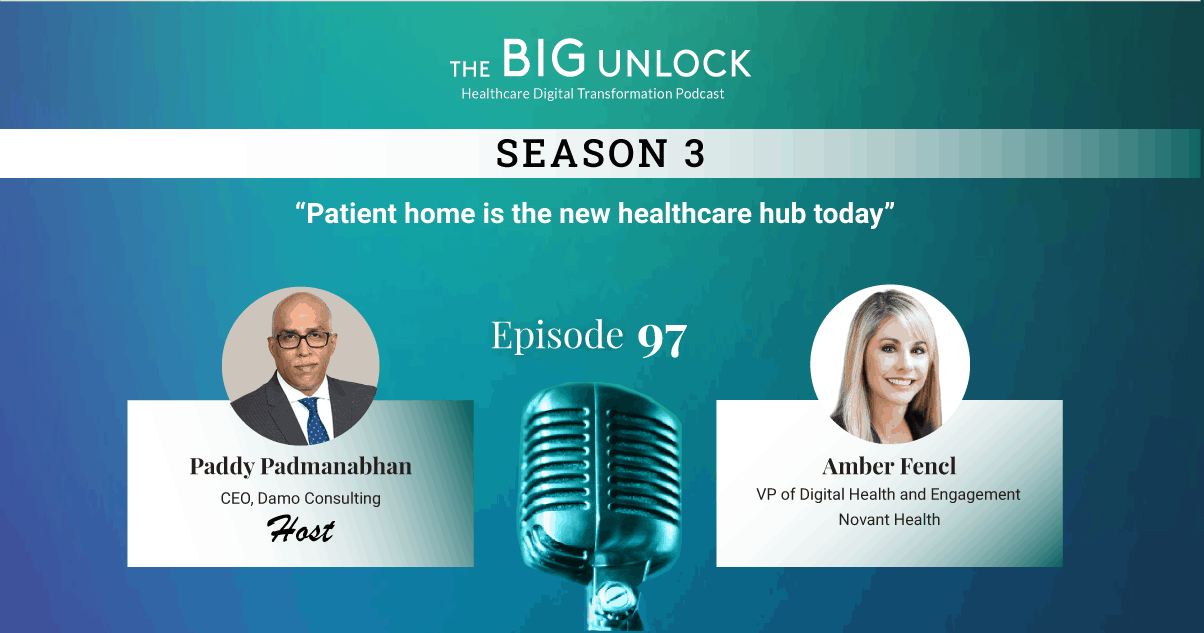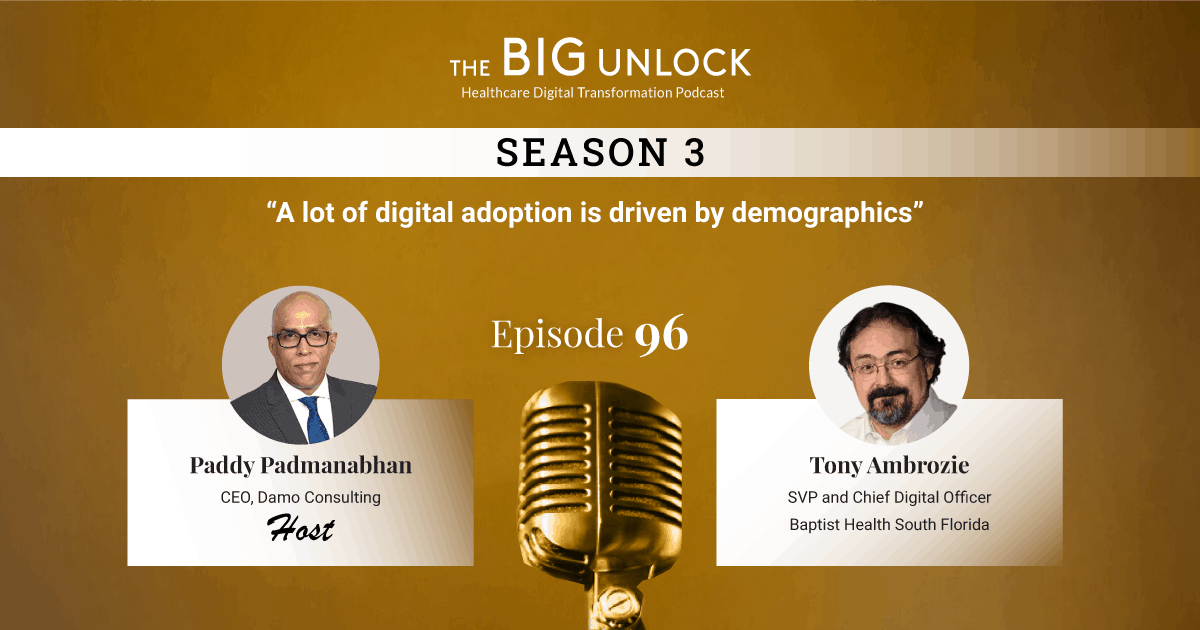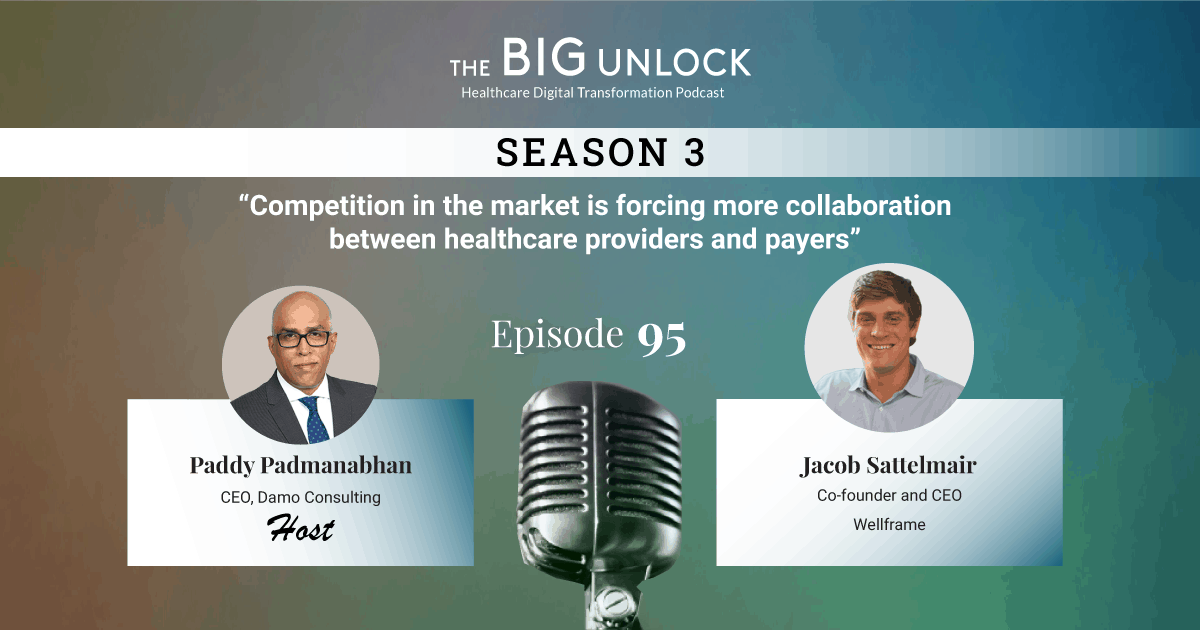Season 3: Episode #97
Podcast with Amber Fencl, VP of Digital Health and Engagement, Novant Health
"Patient home is the new healthcare hub today"
 Hosted by Paddy Padmanabhan
Hosted by Paddy Padmanabhan 
Share
In this podcast, Amber Fencl, VP of Digital Health and Engagement at Novant Health, discusses how innovations in technology are driving healthcare and enabling its seamless, effective delivery into patients’ homes today. They are transforming the home into the new healthcare hub.
From drones that deliver medical supplies and AI-leveraged platforms that detect strokes to harnessing AI voice bots to answering patient questions on COVID vaccine and setting up the remotely monitored COVID-care at home, digital health tools have come a long way. Novant Health is the first healthcare system in the U.S. to get the FAA clearance to use drones for distributing medical supplies during the COVID-19 pandemic. In combination with invaluable consumer insights and when integrated with a robust EHR system, digital health care can only enhance patient-centric care delivery models.
Lastly, but not the least, start with what the consumers need and want to look for, because if you deliver something they’re not interested in, they will not use it. Take a listen.
Show Notes |
||||
| 00:40 | Brief overview of Novant Health and your role in the organization. | |||
| 08:18 | Many health systems have roll-out chatbot program in the context of COVID-19 and looking to go beyond that. What do you think is possible with the chatbots in the next 6-12 months? | |||
| 13:09 | You are combining three different technology tools – chatbots, voice-enabled chatbots, and AI. In terms of the broad functional areas, what are the things that you are planning to roll out in the next year? | |||
| 16:58 | Hospital at home is a theme that we keep hearing a lot. How do you ensure that the experience is in no way degrade in any way by moving services from the hospital to the home? Also, how do you make technology choices in this context? What do you look for in a technology partner on this journey? | |||
| 23:54 | There's a vast amount of VC money being poured into small companies that are very young. If one of them goes under, how do de-risk yourself out of it? Can you share recommendations that you have based on your own experience? | |||
| 27:48 | How do you govern your digital initiatives in your digital health programs at Novant Health? | |||
| 31:46 | What have you learned personally on this journey that you've been on? Can you share that with our listeners and with your peers across the industry? | |||
Q. Amber, can you give us an overview of Novant Health and your role there?
Amber: Novant Health is a not-for-profit, US$ 5.7 billion health system located in North Carolina, South Carolina and Georgia. We have around 15 outpatient and inpatient facilities, about 800 clinic, urgent care locations and over 2300 providers. So, we may be called Super Regional.
Q. We’ve hosted Angela Yochem, Chief Transformation and Digital Health Officer, Novant Health a while ago. Now, you’re handling digital patient engagement. Do share an overview of what’s changed in the last 18 months?
Amber: At Novant, we have been inundated with COVID-19 response to give our patients quick access to the care they want and need. In the last 18 months, that has been a priority for our communities.
However, we have also tried to continue our growth and innovation towards bringing technology into homes in such a way that is meaningful and creates a seamless experience. Before I came into this role, I was working on our consumer-facing product-side. It was a phone call from Angela about “How would you like to lead this team?” that got me thinking. It’s a very natural transition to go beyond just the consumer-facing experience to talk about our digital health experience and initiatives. They span innovations, such as, using drones.
So, we have a partnership with Zipline where we have instituted the delivery of supplies between our facilities. We were the first in the nation to receive FAA clearance to use a drone that is “sight unseen”. So, we lose sight of the drone, and it covers a 30 mile radius to deliver supplies. We are now exploring the next use case with Zipline, and that will be to deliver pharmaceuticals to our patients directly to their homes. So, a drone is going to take their medications and safely and securely, deliver that to their front yard.
We have also partnered with a company called Hyro AI. Hyro is a conversational voice bot technology that will respond to COVID-19 vaccination questions. It’s taken us about four weeks to develop a knowledge base of FAQs related to the vaccine so patients and community members who call-in have the option to speak with this voice Bot to learn more about the vaccine. In a five-month span, we deflected over 13,000 calls from our care connections, our customer service phone team to the bot for people just calling to get more information about the vaccine. So, that was a highly successful initiative with one of our key partners, Hyro.
We have also established what we call COVID-Care at Home, and it’s a great program to assess our inpatient COVID patients. Once they’re in a stable place, and we feel that they have met the selection criteria — an algorithm that confirms that they can recover at home — we will discharge them from our acute facility and send them a care package and remote patient monitoring devices to monitor oxygen levels, etc., so they can comfortably complete recovery at home. Thus, we are also able to alleviate some of the strain that’s on our acute care facilities with that program. And we are doing that across all of our footprints here at Novant Health.
One really cool thing we’ve done is use AI technology for stroke detection. If we have patients that present themselves with stroke symptoms in the ER while they’re in the CT Scanner, the Viz AI and incredible algorithm and technology can assess that patient in real-time, detect and save millions of brain cells per minute and reduce the time spent trying to discern what’s wrong with them. That technology enables us to take swift action within minutes — call in the Neurosurgeon, prepare the OR etc. — at much faster rates.
Q. While emerging technologies and chatbots will play a much bigger role going forward in health care, it looks like every health system has some kind of a program to roll-out now. Do share what you think is possible in the next six to 12 months.
Amber: We are working with our vendor of choice – Hyro — for our web and voice capabilities. I’d say that the chat bot space is becoming very interesting with some out-of-the-box products that you can turn-on and have a chat, instantaneously. What I would offer is if we just turn it on — take the patient, the consumer experience on the other side — just to say that chat and support experience really isn’t worth checking that box because it’s more frustrating. A lot of research here has shown us that about 60% of the digital consumers that we have surveyed, want to self-serve. Chatbots are a great way to self-serve. However, when they want to talk to a person, they still want to be able to get to a person. So, you need to think about that as an organization. What is that ability to still either chat live with the human or transfer them warmly to someone on the phone, if it’s not a webchat? So, yes, people want to self-serve and they want to engage digitally, on their terms, their time and on their mobile device. The majority also are engaging on mobile. So, that capability must be rich and meaningful information. Checking the box and turning it on may not be rewarding to the patient and that’s not going to buy you much either.
As an organization, you need to have robust knowledge. That means looking for technologies like Hyro, for example, that has conversational AI and the robust knowledge graph that is continuously learning, growing its nodes and building relationships with information such that it can constantly ingest and scrape all sorts of different ways to fill the knowledge base and grow it. We want to be able to do that in an effective, efficient, and elegant manner.
Chatbots are more workflow-based. I think they are narrowing and serve the purpose for a very small use case, and can’t grow with you. So, at Novant Health, we have implemented a chatbot with Hyro that serves to search our entire website, if needed. So, you may think you’re about to type in a search term for company information or perhaps you want to find a physician, but what you’re doing is engaging with the chatbot and it will begin a conversation with you, ask questions and narrow down what exactly it is that you’re looking to do. And the chatbot will be used to do that.
I will say that in the space of a chat in AI — here’s the piece that I think folks may not appreciate — we have thankfully begun to scratch the surface here. If you have a conversational AI, some type of natural language processing capability, you are getting consumer insights first-hand. They are typing in, voicing in their questions, so, if you take that that data and analyze it, that is first-hand consumer information for you to make decisions with. It is rich, robust and invaluable. The more we find entities implementing this type of technology and then, using that data to turn it into meaningful information, the more pivotal it will be for that entity to start making very different and customer-focused decisions.
Q. It’s great that you’re leveraging technology like this! In terms of broad functional areas, what are some of the things you’re planning to roll-out in the next year?
Amber: One of our biggest programs that we, along with many other healthcare systems, are exploring is hospital at home. The idea is to take remote patient monitoring — which has become a bit expected – and truly creating an inpatient experience with the same quality and care within the home. This idea is similar to what we did with the TELE-ICU. So, we have the stroke technology with AI. We’ve also created an experience for TELE-ICU where we have a command center of experts in the field to monitor it. And then we have our hospitalists that are there rounding. The hospital at home takes that to a much greater level. This healthcare at home is the new healthcare hub. And we are going to bring an experience into the patient’s home that will enable all their care management, whether it is behavioral health-related, pharmaceutical or some sort of integrative medicine.
It can be something that is more acute for those patients who are better suited to be in the comfort of their home and have the right home environment. It’s going to include labs, imaging, even the ability to do any type of paramedic services.
Let’s say someone’s running low on their oxygen. So, from our command center, we will be able to dispatch that paramedic to them immediately and through the monitoring, technology and the talent that is sitting in that command center offer necessary care. This will be the next great program that we really bring to life.
We began to do it already like in the COVID-Care at-Home program. But what we want to do is to take these individual experiences with a robust set of talent at the command center and stitch it together to take the hospital into the home and provide that level of care just as if they were inside our four walls. And the brick and mortar will have the same quality metrics. We will have the same expectations for our providers, but in a much more accessible and affordable modality to deliver care.
Q. The hospital at home is another theme that we keep hearing a lot — and it’s all work in progress. Question that arises is — how do you make it all seamless as a healthcare service provider? How do you ensure the experience is in no way degrading? How do you make technology choices in this context? What do you look for in a technology partner on this journey?
Amber: The seamless consumer experience is quite the challenge, and we see it on a daily basis. The healthcare technology field has been peppered with point solutions and a lot of good ones, really great ones that came out of COVID, as well. I was reading this weekend there was in the first half of 2021, NRC Health reported, US$ 14.7 billion in venture funding for health technology. That’s huge. It’s booming.
There’s a lot of great technology out there. But the stitching together is where the challenge comes in, and that’s what you alluded to and what I would offer to listeners is when you’re looking to solve a problem, you have to step-up and out to look across, obviously, the whole spectrum of your ecosystem. What we really have become very focused on doing, is looking at it from an ecosystem standpoint rather than a problem-solving standpoint.
So, I think one differentiator of how you first evaluate, then make decisions, think about the perspective in which you’re analyzing it and then, look at the ecosystem. For us, first and foremost to our core is the patient-centric model.
Our digital health is looking at the patient at the very center. I would think of these as concentric ellipses. There’s the patient in the center and then, there’s this provider enablement that has to wrap around that. That is an important point around your providers. You have clinical operations and then, there’s technology that’s wrapping all of that. For you to create a great patient experience and consumer experience, you have to remember that there’s a provider on the other side to deliver that service, whether it’s in a digital or an in-person format and that is a very difficult scale to balance. If it’s great for the patient, it might not always be so great for the provider and what they have to do. So, you really have to look at technology through both of those lenses and figure out what’s a nice compromise to meet in the middle.
Your clinical operations are so burdened right now from the volumes and the strain of COVID for sure. Certainly, people that are trying to get back in for delayed healthcare and then, there’s the potpourri of point solutions that we have brought into our clinical operations to try to solve problems. If we don’t consider how inefficient a new solution may be to the clinic, then, we’re doing those folks a disservice. So, the patients are going to have a bad experience. You really have to think about that piece as well.
As to the technology to wrap, how does Novant approach it? We are looking for a really strong, solid backbone of infrastructure to facilitate this. It has to be a strong foundation that’s going to allow for growth, stability but it must be scalable. So, as we expand that to the hospital at home or into a new digital medicine capability inside the four walls of Novant Health, it must easily integrate. That, too, is another differentiating factor when you’re looking at technology to bring in our eight-point solution. Question that arises then, is, what’s the integration factor here and how easy or hard is it going to be?
There’s also a call to our electronic health record systems to make integration easier. There are great things that better EHRs do and they do it well. But then there are some things that they really don’t. And we need to easily integrate into those spaces and that, today, isn’t so easy. You have to consider that in your evaluation, because the integration to the EHR is what matters for your clinical team.
Q. A few key points here — the integration piece is key. Without a robust integration infrastructure, you are not going to be able to create those seamless experiences. If you’re not able to capture the encounters properly, you won’t be able to bill for it. Plus, patient experience cannot be at the expense of the provider experience.
Now, there’s a vast amount of VC money being poured into very young companies. So, what does it take for them? Who is the risk taker? How do you do skills of tomorrow? If one of them goes under, how do you pull yourself out of it? Do share any one or two recommendations that you have based on your own experience.
Amber: Risk management and mitigation, planning and organizing work really thoughtfully is at the core of how I operate and I’m going to speak from my perspective and not necessarily as an enterprise or as an entity.
When I go to look at a new vendor, there are some challenging questions that I’m going to ask them. A lot of it is to figure out how reality versus the optimistic view that those providers are typically going to offer, the marketing and the sales pitch versus the reality of what it is. So, I will always double whatever they tell me unless it is a very seasoned software provider, service provider with a proven track record.
I’m going to start also managing expectations within my internal partners and my internal stakeholders.
The other thing that I do is bring in a variety of perspectives and talents to credibly challenge the pitch, the solution from a variety of angles. Certainly, there’s a financial conversation on how viable they are financially that we’re going to have to explore.
And then I look for honesty and transparency. The relationship that I start to form with folks that we’re courting, and discernment serves me well to realize where the pitch may be a little more mirrored than an actual reality. I will also have a score card and that is going to be different. We’re familiar with evaluation and score but that allows me to take away any subjectivity based on relationship or conversations, positive or negative. And that of my internal partners as well. So, when we sit down and compare company A with company B, the solutions may be relatively the same. But let’s say, culturally or financially, there’s a risk factors there that don’t align, so we have a more objective way to make that vision absolute.
Q. Coming to governance, how do you govern your digital initiatives in your digital health programs? How do you ensure that cross-functional leadership is involved and you’re prioritizing things the way they are meant to align with organizational needs or goals?
Amber: Its so important to have structure and governance in place. Novant Health has started at the very top with a very innovative, digitally focused CEO. My boss now, Angela Yochem — our Chief Digital and Transformation Officer — reports directly to the CEO. So, there’s a leadership structure in place to support digital growth, advancement and innovation. Having that support is monumental and I think, key to success. If you are an organization that hasn’t quite adopted that model, I would challenge you to think about it. The investment and the level of engagement from across your organization will change positively with that model.
That being said, we also realize that in the digital space, digital health is one thing and it actually used to sit within our medical group. A couple of years ago, it was realized that digital health spans far beyond just our normal clinical practices. So, it was lifted out and put within the digital products and services group which we’d set. That allows us to be surrounded with more technology and innovative tech skill sets, when we’re looking to solve our problems and introduce new things.
But from a governance standpoint, we have a Digital Care Steering Committee that comprises key stakeholders in the organization — financial partners, strategy partners, revenue growth partners, and most importantly, medical practice. That steering committee is where we bring forward new ideas. Certainly, those new ideas may be bumping up against some internal criteria but we also hear from the Committee the things that may be on their minds. We have a very close partnership with our medical group and outside of the Steering Committee, we have regular Cadence Reports out and touch base on key initiatives.
That Steering Committee’s really the glue that brings us all together where we very intentionally talk about what we want to do and where we want to go. Here’s the reality of what’s happening within the medical group from the front lines. Maybe we want to do it, but because of the surge, we have had to make some changes in priorities of the way because our clinical partners need to be serving our patients in the community. That is the forum. And that core group of individuals help us to make those decisions and to talk about it.
Our clinical partners embrace technology and the efficiencies that technology can bring. They also keep us very honest on the point that I’ve talked about before. And what is the lift and the impact to their clinical team members and not just our patients? It’s caring for the patient, giving him the best experience possible while also enabling that provider to do it effectively and efficiently.
Q. What have you learned personally on this journey that you’ve been on? Can you share that with our listeners and with your peers across the industry?
Amber: Yes, I have been impressed, surprised and educated through consumer insights — the level of detail and insights — that I was never privy to before. At Novant Health, we have a consumer patient-focused group called Community Voice. That function is a part of my digital health and engagement team and has about 6,000 volunteer patients, team members and community members that will take surveys that we send out because they are interested in providing us feedback.
And what we may think is a good idea or how we got to do this, may be a game changer and may be great for the patient but it may not be a big deal to the providers. So, we’ll test this concept with our Community Voice members. It’s a very diverse group of individuals. We create these surveys to get their feedback and we’ll find out something that we think may be the next great thing. But it may turn out that it’s really not that important, or what we thought was a great idea is good and the way we wanted to deliver it is not at all how that consumer would want to receive it.
My point is: Finding a way to glean those insights from your demographics in your community is critical and different and very important because it’s a part of your community. You know that it is impactful and it represents those who you are serving. If you are gaining your insights from a different source, that is interesting and absolutely can be a factor.
I have been impressed and find that our community members who participate and give us direct feedback allows us — sometimes it’s directionally the same as perhaps a national survey on a similar topic — but it’s typically different enough to make an impact on how Novant Health wants to choose to deliver that particular concept.
So, that is first and foremost, and what I mentioned earlier, is the insights that you can gain from digital interactions with your patients to predict behaviors, identify trends quick enough that you can react and respond to them so that either the experience is better or perhaps there is a new opportunity in those trends that is good for your system to explore.
For me in this role and the work that I’ve been doing at Novant Health the last couple of years, the access to meaningful insights to make decisions has been delightful and impactful and how we have made decisions that have been a part of that’s wonderful.
Q. So, the cool tech is where you start with really what the consumers need and want to look for. And if there happens to be a cool tech that can deliver what they need, even better.
Amber: Better and better. But if they’re not interested in it, you can have all the cool stuff you want. Nobody’s going to use it.
We hope you enjoyed this podcast. Subscribe to our podcast series at www.thebigunlock.com and write to us at [email protected]
Disclaimer: This Q&A has been derived from the podcast transcript and has been edited for readability and clarity
About our guest

As the VP of Digital Health & Engagement, Amber is responsible for leading game-changing digital health and digital medicine initiatives through advanced technologies so that Novant Health can deliver the most remarkable patient experience. Amber’s team strives to improve the quality of care for patients and community members; and ensure increased access to care through contemporary methods and technologies. She partners with physician and administrative leaders across the organization to develop and operationalize a robust, omni-channel digital health and innovative engagement product strategy.
Amber is a digital transformation leader with expertise in healthcare technology, software development, portfolio and project management, and risk mitigation. From start-ups to Fortune 500 companies, Amber has held leadership roles across technology, financial services, and healthcare with companies such as Unisys, Oracle, Wells Fargo, and Novant Health.
Recent Episodes
About the host
Paddy is the co-author of Healthcare Digital Transformation – How Consumerism, Technology and Pandemic are Accelerating the Future (Taylor & Francis, Aug 2020), along with Edward W. Marx. Paddy is also the author of the best-selling book The Big Unlock – Harnessing Data and Growing Digital Health Businesses in a Value-based Care Era (Archway Publishing, 2017). He is the host of the highly subscribed The Big Unlock podcast on digital transformation in healthcare featuring C-level executives from the healthcare and technology sectors. He is widely published and has a by-lined column in CIO Magazine and other respected industry publications.






